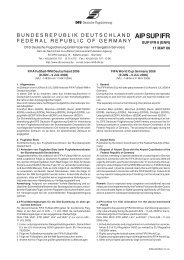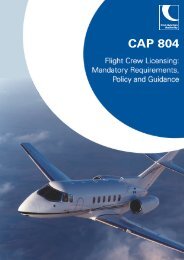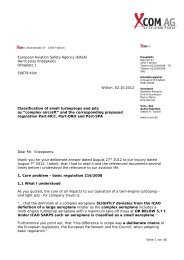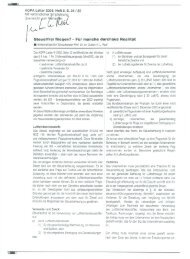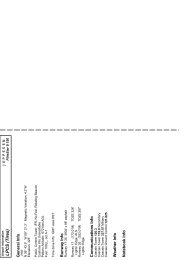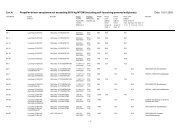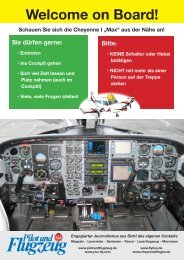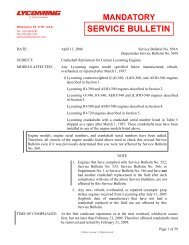GNS530 Quick Reference - Pilot und Flugzeug
GNS530 Quick Reference - Pilot und Flugzeug
GNS530 Quick Reference - Pilot und Flugzeug
You also want an ePaper? Increase the reach of your titles
YUMPU automatically turns print PDFs into web optimized ePapers that Google loves.
FLYING AN APPROACH<br />
Activating the approach with vectors to<br />
final:<br />
1) With an approach loaded in the active flight<br />
plan, press the PROC Key to display the<br />
Procedures Page.<br />
2) Turn the large right knob to highlight ‘Activate<br />
Vector-To-Final?’ and press the ENT Key.<br />
Guidelines for Flying an Approach<br />
Due to the variety of available approach procedures,<br />
the specific steps required will vary according to the<br />
approach selected. Keep in mind the following while<br />
flying the approach:<br />
• Selecting the destination airport as the last<br />
waypoint in the active flight plan, or using the<br />
Direct-to Key ensures that the desired waypoint<br />
will automatically appear when choosing the<br />
‘Select Approach?’ option from the Procedures<br />
Page. Otherwise, the airport should be selected<br />
first, then the approach procedure.<br />
• As the aircraft progresses to each approach<br />
waypoint, a waypoint alert message (‘NEXT<br />
DTK # # #º’) will appear along the bottom of the<br />
display (see page 15).<br />
• Turn advisories (‘TURN TO # # #º’) will appear<br />
along the bottom of the display (see page 15)<br />
when the pilot should begin a course change (via<br />
a standard rate turn).<br />
• For GPS-based approaches, receiver autonomous<br />
integrity monitoring (RAIM) monitors satellite<br />
conditions and alerts the pilot using an ‘INTEG’<br />
or ‘WARN’ annunciation at the bottom left corner<br />
of the display (see page 15) if protection limits<br />
cannot be maintained. If this occurs, the GPS<br />
receiver should not be used for primary navigation<br />
guidance. Revert to an alternate navigation<br />
source, or select an alternate destination airport.<br />
• Within 30 nm of the destination airport, CDI<br />
scaling will transition from 5.0 nm (enroute<br />
mode, ‘ENR’) to 1.0 nm (terminal mode, ‘TERM’)<br />
or when leaving the departure airport, from 1.0 to<br />
5.0 nm. Within 2.0 nm of the final approach fix,<br />
GPS-based approaches will see a second transition<br />
from 1.0 to 0.3 nm (approach mode, ‘APR’).<br />
• A ‘START PROC TRN’ prompt will appear along<br />
the bottom of the display to advise the pilot<br />
when the aircraft is at a safe distance to initiate a<br />
procedure turn. The procedure turn is displayed<br />
on the Map Page, but guidance through the turn<br />
itself is not provided.<br />
• Alerts for proper holding pattern entry (e.g.,<br />
‘HOLD DIRECT’) are displayed along the<br />
bottom of the display. Waypoint sequencing is<br />
automatically suspended (indicated by ‘SUSP<br />
directly above the OBS Key) at the holding<br />
waypoint. Press the OBS Key again to return<br />
to automatic waypoint sequencing. For course<br />
reversals, waypoint sequencing is suspended<br />
for one trip aro<strong>und</strong> the holding pattern only<br />
(after which it will return to automatic waypoint<br />
sequencing).<br />
20 GNS 530(A) <strong>Quick</strong> <strong>Reference</strong><br />
190-00181-01 Rev. G





